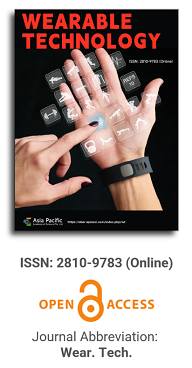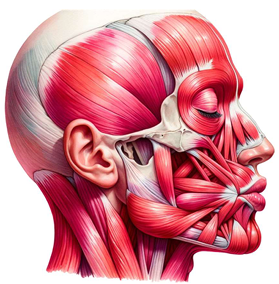

This paper delves deeply into the innovative realm of integrating human emotions with wearable technology. The primary focus is on the conceptualization and development of a kiss transfer device that harnesses the power of wearable technology to bridge the physical gap in human-human interactions. By investigating the intricate nuances of the human-human kissing process, the research seeks to replicate this intimate gesture through a technological medium. The paper not only elaborates on the anatomy, evolution, and hormonal dynamics of kissing but also underscores the transformative potential of wearable technology in capturing and transmitting these intimate moments. This exploration opens up new horizons for long-distance relationships, offering a tangible touchpoint that goes beyond traditional communication methods. Through this pioneering work, the research positions wearable technology as not just a tool for communication but as an extension of our human emotions and expressions.

Study on research mode of smart safety outfits system for children
Vol 3, Issue 1, 2022
Download PDF
Abstract
According to the special characteristics of children’s body and mind and the concept of human–computer interaction, the research and development model of children’s intelligent safety clothing is explored and a A practical research model. Based on the multi–dimensional needs of consumers for children’s clothing and the performance of smart components, we explore the combination of smart wearable equipment and children’s safety clothing, and propose a design process architecture that takes into account function and aesthetics. Through the analysis of the connection technology between smart clothing and mobile terminals, we propose the idea from single interaction to multi–device co–connection, and establish a multi–interaction smart clothing based on the optimal allocation of energy and high. Through the analysis of the connection technology between smart clothing and mobile terminals, we propose the idea of moving from single interaction to multi–device co–connection, and establish the R&D process of multi–interaction smart wearable devices based on optimal energy allocation and efficient information transmission.
Keywords
References
- Li Y. New generation of intelligent terminals-wearable devices. China Academic Journal 2013; 9(10): 82–85.
- Zhang T. Applied research of intelligent textile fiber materials. Advanced Materials Research 2013; (706–708): 11–14.
- Mondal S. Phase change materials for smart textiles—An overview. Applied Thermal Engineering 2008; 28(11): 1536–1550.
- Coyle S, Wu Y, Lau KT. Smart nanotextiles: A review of materials and applications. Mrs Bulletin 2007; 32(5): 434–442.
- Shim BS, Chen W, Doty C. Smart electronic yarns and wearable fabrics for human biomonitoring made by carbon nanotube coating with polyelectrolytes. Nano Letters 2008; 8(12): 4151–4157.
- Lymberis A, Paradiso R. Smart fabrics and interactive textile enabling wearable personal application: R&D state of the art and future challenges. 30th Annual International Conference of the IEEE, Engineering in Medicinc and Bilogy Society. Vancouver, BC: IEEE 2008: 5270–5273.
- Radetic M. Functionalization of textile materials with silver nanoparticles. Journal of Materials Science 2013; 48(1): 95–107.
- Park S, Jayaraman S. Smart textile–based wearable biomedical systems: A transition plan for research to reality. IEEE Transactions on Information Technology in Biomedicine 2010; 14(1): 86–92.
- Han F, li YL. Wearable technology and smart clothing. Chemical Fiber and Textile Technology, 2015; 44(4): 43–45.
- Cho G. Smart clothing: Technology and applications. Behavior and Information Technology 2009; 30(2): 287–288.
- Park S, Jayaraman S. Enhancing the quality of life through wearable technology. Engineering in Medicine and Biology Magazine 2003; 22(3): 41–48.
- Mntyjrvi J, Hoisko J, Kaario J (Inventor) System and Method for Smart Clothing and Wearable Electronic Devices. US patent. 680, 114,0. 2004 Oct 05.
- Radetic M. Functionalization of textile materials with silver nanoparticles. Journal of Materials Science 2013; 48(1): 95–107.
- Shaoran W, Cheng L. Now and future: Intelligent wearable devices. Light Weapons 2015(5): 10–13.
- Miao T, Jun L. Design mode and development tendency of smart clothing. Journal of Textile Research 2014; 35(2): 109–115.
- Li HQ, Yang HJ, Li EB, et al. Wearable sensors in intelligent clothing for measuring human body temperature based on optical fiber Bragg grating. Optics Express 2012; 20(11): 11740–11752.
- Anon. Intelligent deformed clothing equipped with intel curie wearing block. China Apparel 2015(10): 53–54.
- Wu ML. 2016 those things about intelligent wearable devices. Communications World 2016(1): 60–61
- Yu Y. Research on the design of wearable children’s safety products. Shanghai: East China University of technology 2015.
- Hong WJ. Research on intelligent children’s near–field positioning safety clothing. Wuxi: Jiangnan University 2014.
- Lin HL. Research on design of children’s wearable devices. Art Panorama 2015(6): 113.
- Goodwin K. Designing for the digital age: how to create human–centered products and services. Technical Communication 2009; 57(1): 112–113.
- Rouse WB. Design for success: A human-centered approach to designing successful products and systems. New York: Wiley Interscience; 1991.
- Lei S, Hu Y. Childrenwear’s safety standards and its inspection item analysis. Shanghai Textile Science and Technology 2011; 9(39): 58–60.
- Ritchie J, Spencer L, O’Connor W. Carrying out qualitative analysis. Ritchie J, Leueis J (editors). Qualitative research practice: A Guide for social science students and researchers. London: Sage Publication; 2003. p. 219–262.
- Stone H, Sidel J, Oliver S, et al. Sensory evaluation by quantitative descriptive analysis. Gacula MC (editor). Descriptive Sensory Analysis in Practice. New York: John Wiley & Sons, Inc; 2008: 23–34.
- Mann S. Smart clothing: The shift to wearable computing. Communications of the ACM 1996; 39(8): 23–24.
- Zhang PY. Realization of energy and function—essential design principles of wearable devices. Electronics World 2014(5): 196–196.
- Doukas C, Maglogiannis I. Managing wearable sensor data through cloud computing. Third International Conference on Cloud Computing Technology and Sciencel; Athens, Greece: 2011. p. 440–445.
- Hiremath S, Yang G, Mankodiya K. Wearable Internet of things: concept, architectural components and promises for person-centered healthcare. European Alliance for Innovation 4th International Conference on Wireless Mobile Communication and Healthcare; Athens, Greece: 2014. p. 304–307.
- Meilgaard MC, Carr BT, Civille GV. Sensory evaluation techniques. Boca Raton: CRC Press; 2006.
- Stone H, Bleibaum R, Thomas HA. Sensory evaluation practices. London: Academic Press; 2012.
Supporting Agencies
Copyright (c) 2022 Zhebin Xue, Lei Shen, Xiangfang Ren

This work is licensed under a Creative Commons Attribution 4.0 International License.

Prof. Zhen Cao
College of Information Science & Electronic Engineering, Zhejiang University
China, China
Processing Speed
-
-
-
- <5 days from submission to initial review decision;
- 62% acceptance rate
-
-
Asia Pacific Academy of Science Pte. Ltd. (APACSCI) specializes in international journal publishing. APACSCI adopts the open access publishing model and provides an important communication bridge for academic groups whose interest fields include engineering, technology, medicine, computer, mathematics, agriculture and forestry, and environment.





